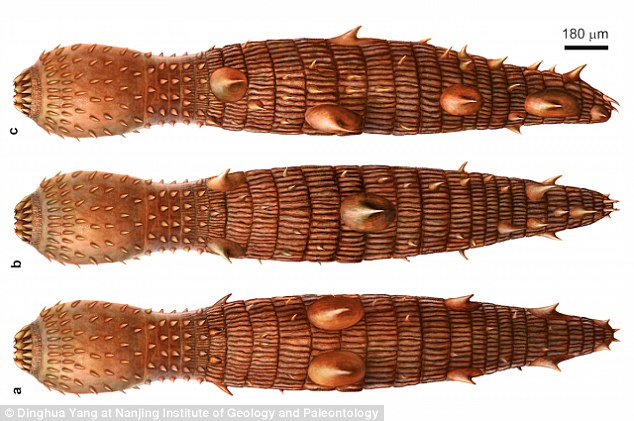Researchers believe it is an early ancestor of today's 'mud dragons'
Fossils of a 535 million-year-old 'mud dragon' have been discovered in China.
The creature had an armored body, rows of spines and a mouth ringed with sharp teeth, causing some to liken it to the terrifying sandworms from the 'Dune' sci-fi novels.
But while its appearance may sound fearsome, the marine creature was just a few millimetres in length and an early ancestor to today's 'kinorhynch'.
The discovery, made by researchers in China's Nanjiang County, could provide important clues on how creatures with segmented bodies, such as worms, evolved.
The area studied was once covered by a phosphate-rich ocean, where the newly-discovered creature, dubbed Eokinorhynchus raru, thrived.
'These tiny worms probably lived in the interstitial spaces within sandy sediments, so they likely used the spiky spines to anchor themselves when navigating among sand grains,' Virginia Tech's Shuhai Xiao told IFLScience.
'They may have also functioned as defensive structures.'
The phosphate in the oceans fossilised the worm-like creatures, causing their bodies to transform into the same material that makes teeth and bones, according to an in-depth report by Live Science.
The creature is believed to have had 20 armored body segments, each one circled by plates and studded with spines.
It may be an ancestor of marine invertebrates called kinorhynchs, also known as mud dragons, according to the findings published in Scientific Reports.
Today, around 240 kinorhynch species exist, and their bodies are divided into three segments; the head, the neck and the trunk.
The head includes a mouth cone with circlets of teeth, and the trunk is further split up into 11 segments.
Earlier studies suggested that the species diverged just before the Cambrian, but up until now, no kinorhynch fossils have been found.
The team found a number of similarities between the new extinct species and today's kinorhynchs to suggest that they may be related.
Both creatures have trunks that are divided into segments, each made up of small plates. They also both have hollow spines called spinose sclerites.
The main difference is that E. rarus has five pairs of large spikes arranged around the trunk, one spine located in the middle of its body and two pairs of spines located near the anus.
Despite being around for a billion years, the fossil record of kinorhynchs has huge gaps.
The latest discovery could help provide a clearer understanding of the species, as well as provide vital clues to how segmented bodied evolved.

